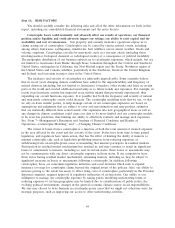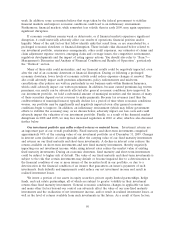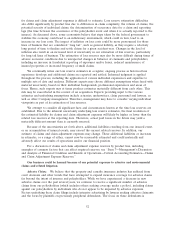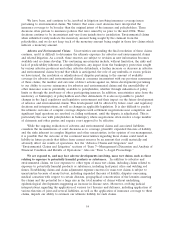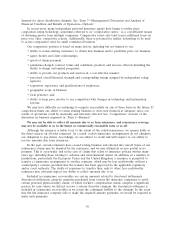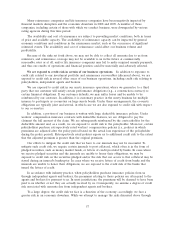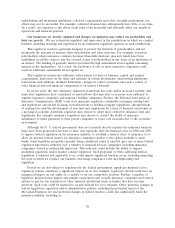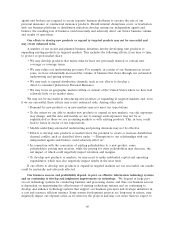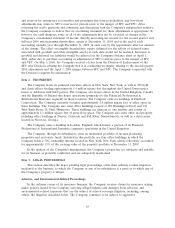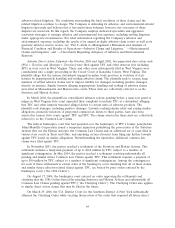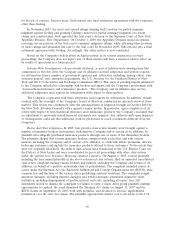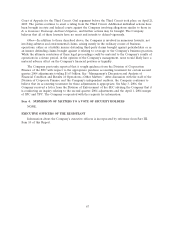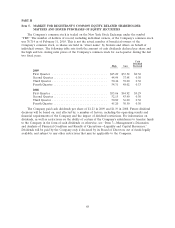Travelers 2009 Annual Report Download - page 70
Download and view the complete annual report
Please find page 70 of the 2009 Travelers annual report below. You can navigate through the pages in the report by either clicking on the pages listed below, or by using the keyword search tool below to find specific information within the annual report.underwriting and investment guidelines, collateral requirements and other oversight mechanisms, our
efforts may not be successful. For example, collateral obtained may subsequently have little or no value.
As a result, our exposure to the above credit risks could materially and adversely affect our results of
operations and financial position.
Our businesses are heavily regulated and changes in regulation may reduce our profitability and
limit our growth. We are extensively regulated and supervised in the jurisdictions in which we conduct
business, including licensing and supervision by governmental regulatory agencies in such jurisdictions.
This regulatory system is generally designed to protect the interests of policyholders, and not
necessarily the interests of insurers, their shareholders and other investors. For example, to protect
policyholders whose insurance company becomes financially insolvent, guaranty funds have been
established in all fifty states to pay the covered claims of policyholders in the event of an insolvency of
an insurer. The funding of guaranty funds is provided through assessments levied against remaining
insurers in the marketplace. As a result, the insolvency of one or more insurance companies could
result in additional assessments levied against us.
This regulatory system also addresses authorization for lines of business, capital and surplus
requirements, limitations on the types and amounts of certain investments, underwriting limitations,
transactions with affiliates, dividend limitations, changes in control, premium rates and a variety of
other financial and non-financial components of an insurer’s business.
In recent years, the state insurance regulatory framework has come under increased scrutiny, and
some state legislatures have considered or enacted laws that may alter or increase state authority to
regulate insurance companies and insurance holding companies. Further, the National Association of
Insurance Commissioners (NAIC) and state insurance regulators continually reexamine existing laws
and regulations, specifically focusing on modifications to holding company regulations, interpretations
of existing laws and the development of new laws and regulations. In a time of financial uncertainty or
a prolonged economic downturn, regulators may choose to adopt more restrictive insurance laws and
regulations. For example, insurance regulators may choose to restrict the ability of insurance
subsidiaries to make payments to their parent companies or reject rate increases due to the economic
environment.
Although the U. S. federal government does not currently directly regulate the insurance business,
there have been proposals from time to time, and especially after the financial crisis in 2008 and 2009,
to impose federal regulation on the insurance industry, to establish a federal office of insurance or to
allow an optional federal charter for insurance companies, similar to the option available to most
banks. Some legislative proposals currently being considered could, if enacted, give one or more federal
regulators supervisory authority over a number of financial services companies, including insurance
companies, viewed as systemically important. This authority could include the ability to impose
prudential regulation and/or market conduct regulation. Such proposals or other additional federal
regulation, if adopted and applicable to us, could impose significant burdens on us, including impacting
the ways in which we conduct our business, increasing compliance costs and duplicating state
regulation.
Even if we are not subject to regulation by the federal government, significant financial sector
regulatory reform could have a significant impact on us. For example, regulatory reform could have an
unexpected impact on our rights as a creditor or on our competitive position. Further, a number of
legislative proposals may impose assessments on property and casualty insurance companies and related
entities to pay for the resolution of other financial institutions (such as banks) that have become
insolvent. Such costs could be material to us and difficult for us to estimate. Other potential changes in
federal legislation, regulation and/or administrative policies, including the potential repeal of the
McCarran-Ferguson Act and potential changes in federal taxation, could also significantly harm the
insurance industry, including us.
58


